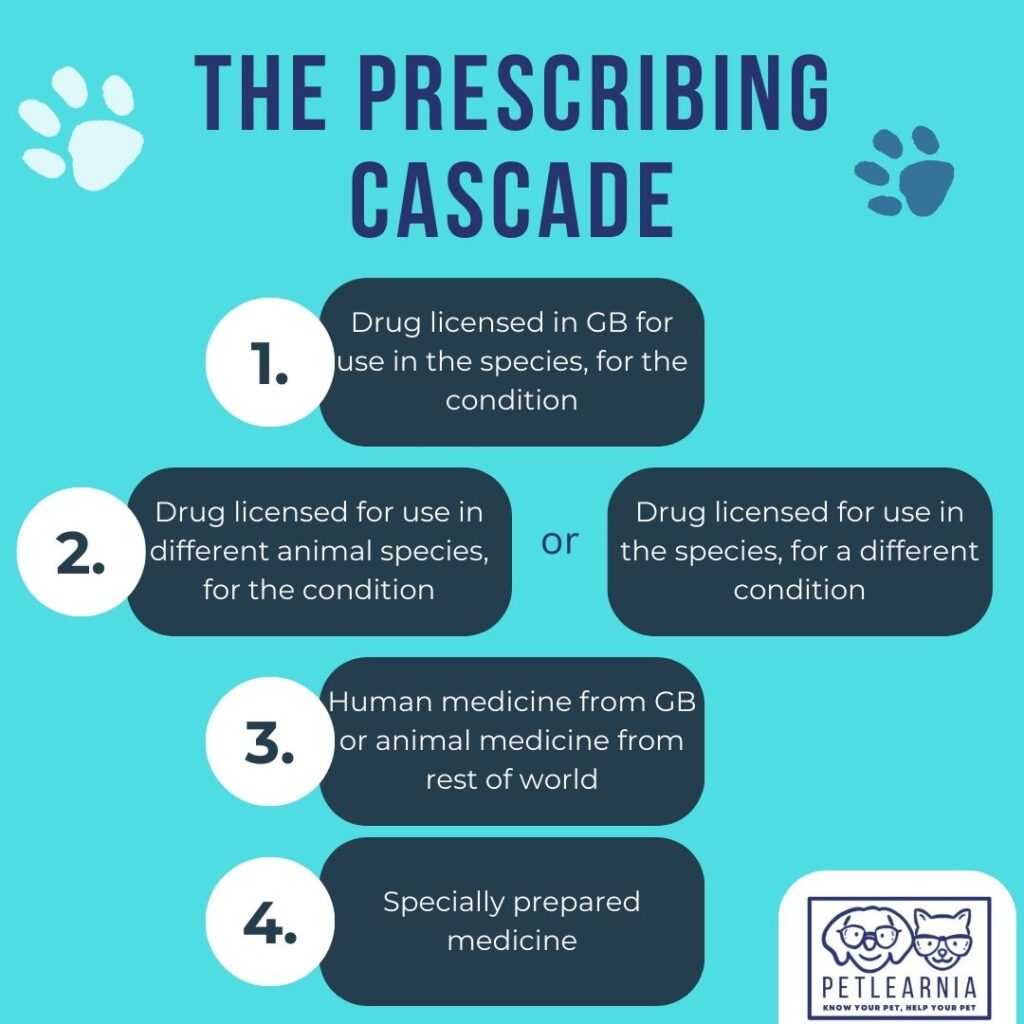The Prescribing Cascade
The prescribing cascade is a framework used by veterinarians to select which prescription product to use when there isn’t an authorised veterinary medicine available. The cascade works like a decision-making tree, which guides veterinarians into making the next best decision on a case-case basis.
Whenever possible, your vet will prescribe a drug that is licensed in Great Britain for the species and condition presented. However, when there’s not a drug available, they can move down the cascade to find an alternative. This drug would be used ‘off-license’ or ‘off-label’. Vets might need to move to the next level on the cascade due to:
- Unavailability of drug
- Emergencies
- Cost of drug
- Different dosage strengths required
- Different formulation required
- Contraindications
- High risk of side effects
- Species with limited licensed medications available e.g. exotics
Unfortunately, cost (or inability to afford) is not allowed as a reason to use an unlicensed product under the cascade.
If your vet is unable to select a product that is authorised for that species and condition, they will work their way down the cascade to select the next most suitable product.
This image shows the flow through the prescribing cascade. The vet must consider the options in this order, moving to the next level only if there’s nothing suitable.

What is an off-license drug?
Using an ‘off-license’ or ‘off-label’ drug means that it has been prescribed under the cascade and is not authorised for use in that species or condition. In other words, the label doesn’t say the exact species and condition on it, hence ‘off-label’. Your vet will only provide your pet with an off-license drug if there isn’t a suitable licensed product.
Who can prescribe under the cascade?
Only qualified veterinary surgeons will be able to prescribe veterinary medications under the cascade. They will make decisions based on the level of risk and the circumstances presented to them. Your vet will assess your pet to ensure that the unauthorised drug being prescribed is safe and suitable for your pet.
What is a specially prepared medicine?
A specially prepared medicine is specifically formulated for an individual patient. This may be done when authorised drugs do not have suitable formulations or dosage strengths. An example is some human tablet medications used in cats, which your vet may be able to provide as a specially-formulated liquid if the tablet isn’t suitable.
Examples to help you understand the prescribing Cascade:
- Your dog has arthritis and is given a veterinary prescription for Metacam 1.5mg/ml oral solution for dogs, an anti-inflammatory drug licensed for dogs with inflammation. This is a licensed drug.
- Your dog has severe arthritis, and your vet wants to add gabapentin to help control their pain. There are no gabapentin products for dogs, so the vet moves down the cascade until they find a suitable option – a human gabapentin product.
Your vet is prescribing an off-license drug. However, thanks to their training and knowledge they have made a safe and informed decision. Your vet should always inform you of the risks if they are prescribing under the cascade. - Your cat has hyperthyroidism and has been prescribed methimazole tablets, but you are struggling to get your cat to take them. Your vet orders a specially-prepared ointment from a pharmacist instead – they safely turn this oral medicine into a topical version. Your vet would now be prescribing methimazole under the cascade, as a specially prepared medicine has been given to the individual. To be allowed to do this, your vet first has to rule out oral liquid versions for cats as well as human ointments to satisfy the prescribing laws.
- Why Do Dogs Sleep So Much? A Vet Explains What’s Normal (and What’s Not) - March 27, 2025
- 10 Signs Your Dog Needs Probiotics – Vet Explains When to Supplement - March 14, 2025
- The dog gut microbiome explained (by a vet) - March 10, 2025

